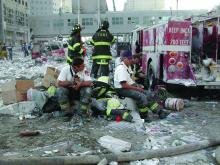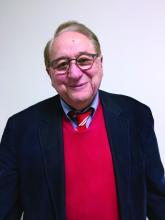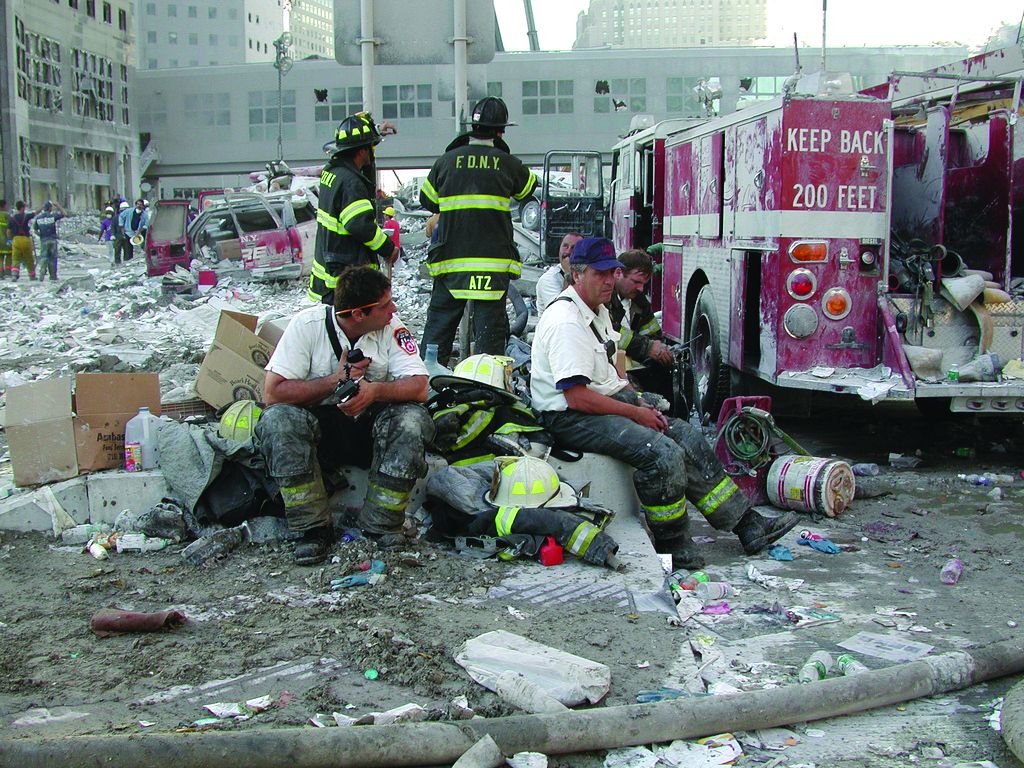User login
On June 10, 2019, a rainy, foggy day, there was a news flash that a plane had crashed into a building in the middle of New York City. I first saw this notification on my iPhone and my immediate thought was: Could this be a redo of Sept. 11?
I was especially concerned because I knew the area fairly well, in that a clinic I had worked in for more than 10 years was only a few blocks away. However, my memory bank brought me back to that day almost 18 years ago when, from a hospital window, many of us doctors, nurses, social workers, and patients saw the fire in the north tower and then saw the second plane crash into the south tower of the World Trade Center. Once we all knew what happened, we spent that night at the hospital awaiting the arrival of people in need of care. Unfortunately, very few arrived.
On this past June day, before anyone really knew the facts, what we heard and saw on TV was buildings being evacuated in midtown Manhattan, people running and moving in all directions with police officers directing people and diverting traffic, firemen entering the building, and EMT first responders in place. What mayhem!
Gov. Andrew Cuomo got to the scene very quickly and assured us that the incident did not appear to be a terrorist attack. Furthermore, he thoughtfully pointed out, we in New York City all seem to have a version or a form of posttraumatic stress disorder taking us back to Sept. 11, 2001. From my point of view, Gov. Cuomo could not have been more correct in his short, televised talk to a nervous public. The incident, and the governor’s reaction to it, started me thinking about how easily triggered the memories and flashbacks of PTSD can be.
It became clear very soon that a pilot had lost control of the helicopter on that foggy, rainy June day and had tried to make an emergency landing on the roof of a Manhattan high-rise. The roof landing did not go well; the helicopter crashed on the roof; and the lone pilot died.
As it turned out, mental health care workers treated many PTSD sufferers at the Bellevue and Mount Sinai hospital programs set up after Sept. 11, including those who were part of the rescue as well as the clean-up. In addition, it appears that many who witnessed the disaster also were vulnerable to PTSD and were additionally treated in various programs. I have seen and interviewed many of those people over the last 10 years.
PTSD is defined mainly in terms of experiencing a traumatic event during a man-made or natural disaster: torture, assaults, the tragedies of war, or any event that causes physical or psychological injury. According to research, it can occur right after the event or years later. Besides those major traumatic events, I’ve seen PTSD occur from much lesser traumas; much depends on how individuals process what is happening around them. For example, in some people, I’ve seen PTSD occur after job loss, where identity and persona are lost and the brain experiences the psychological shock consistent with more dangerously threatening aspects of PTSD. I’ve seen dog bites, auto accidents, even “fender benders” and emotional break-ups bring out the symptoms of PTSD (J Adv Nurs. 2005 Oct;52[1]:22-30). Luckily, in most of those cases, treatment or time itself can heal the problems.
Going back to that June day, for a few brief moments, my memory was jogged back to Sept. 11. A few people I spoke with about the event last month also reported being taken back to that fateful day (Am Psychol. 2011 Sep;66[6]:429-46).
For some experiencing PTSD, flashbacks to the physically threatening or psychologically shocking event occur as opposed to memory alone. During a flashback, the person actually relives the experience as if it were in the present. Flashbacks are quite different from recall alone. In my experience, the flashback is not unlike age regression, where an individual actually relives an event as opposed to having a memory of an event.
PTSD is a serious emotional problem, and I believe that much of it is undiagnosed in society – partly because we tend to look for the disorder after major traumatic events, such as physical and psychological effects of war or disaster, man-made and natural disasters, as well as assaults and torture. As we know in medicine and mental health care, there are certain vulnerabilities to some disorders. I believe that, whether through education, environment, or genetics, we have vulnerabilities to PTSD (Brain Behav Immun. 2013 May;30:12-21); (Clin Psychol Rev. 2012 Nov;32[7]:630-41), not only from major disastrous physical and psychological shocks but less obvious events in life that might create the same clinical picture we see in more traditional cases of PTSD.
Some PTSD survivors will improve and get better with time. Others do well after getting treatments with interventions such as cognitive-behavioral therapy (CBT) and prolonged exposure therapy, both of which are fairly short term in many instances. An ongoing relationship with a supportive therapist or friends and family is extremely important, in order to keep PTSD survivors from isolating and endlessly “living in their heads” as they relive the experience and face the multiple symptom complexes of PTSD.
Dr. London is a practicing psychiatrist and has been a newspaper columnist for 35 years, specializing in and writing about short-term therapy, including CBT and guided imagery. He recently published a book called “Find Freedom Fast” (New York: Kettlehole Publishing, 2018).
On June 10, 2019, a rainy, foggy day, there was a news flash that a plane had crashed into a building in the middle of New York City. I first saw this notification on my iPhone and my immediate thought was: Could this be a redo of Sept. 11?
I was especially concerned because I knew the area fairly well, in that a clinic I had worked in for more than 10 years was only a few blocks away. However, my memory bank brought me back to that day almost 18 years ago when, from a hospital window, many of us doctors, nurses, social workers, and patients saw the fire in the north tower and then saw the second plane crash into the south tower of the World Trade Center. Once we all knew what happened, we spent that night at the hospital awaiting the arrival of people in need of care. Unfortunately, very few arrived.
On this past June day, before anyone really knew the facts, what we heard and saw on TV was buildings being evacuated in midtown Manhattan, people running and moving in all directions with police officers directing people and diverting traffic, firemen entering the building, and EMT first responders in place. What mayhem!
Gov. Andrew Cuomo got to the scene very quickly and assured us that the incident did not appear to be a terrorist attack. Furthermore, he thoughtfully pointed out, we in New York City all seem to have a version or a form of posttraumatic stress disorder taking us back to Sept. 11, 2001. From my point of view, Gov. Cuomo could not have been more correct in his short, televised talk to a nervous public. The incident, and the governor’s reaction to it, started me thinking about how easily triggered the memories and flashbacks of PTSD can be.
It became clear very soon that a pilot had lost control of the helicopter on that foggy, rainy June day and had tried to make an emergency landing on the roof of a Manhattan high-rise. The roof landing did not go well; the helicopter crashed on the roof; and the lone pilot died.
As it turned out, mental health care workers treated many PTSD sufferers at the Bellevue and Mount Sinai hospital programs set up after Sept. 11, including those who were part of the rescue as well as the clean-up. In addition, it appears that many who witnessed the disaster also were vulnerable to PTSD and were additionally treated in various programs. I have seen and interviewed many of those people over the last 10 years.
PTSD is defined mainly in terms of experiencing a traumatic event during a man-made or natural disaster: torture, assaults, the tragedies of war, or any event that causes physical or psychological injury. According to research, it can occur right after the event or years later. Besides those major traumatic events, I’ve seen PTSD occur from much lesser traumas; much depends on how individuals process what is happening around them. For example, in some people, I’ve seen PTSD occur after job loss, where identity and persona are lost and the brain experiences the psychological shock consistent with more dangerously threatening aspects of PTSD. I’ve seen dog bites, auto accidents, even “fender benders” and emotional break-ups bring out the symptoms of PTSD (J Adv Nurs. 2005 Oct;52[1]:22-30). Luckily, in most of those cases, treatment or time itself can heal the problems.
Going back to that June day, for a few brief moments, my memory was jogged back to Sept. 11. A few people I spoke with about the event last month also reported being taken back to that fateful day (Am Psychol. 2011 Sep;66[6]:429-46).
For some experiencing PTSD, flashbacks to the physically threatening or psychologically shocking event occur as opposed to memory alone. During a flashback, the person actually relives the experience as if it were in the present. Flashbacks are quite different from recall alone. In my experience, the flashback is not unlike age regression, where an individual actually relives an event as opposed to having a memory of an event.
PTSD is a serious emotional problem, and I believe that much of it is undiagnosed in society – partly because we tend to look for the disorder after major traumatic events, such as physical and psychological effects of war or disaster, man-made and natural disasters, as well as assaults and torture. As we know in medicine and mental health care, there are certain vulnerabilities to some disorders. I believe that, whether through education, environment, or genetics, we have vulnerabilities to PTSD (Brain Behav Immun. 2013 May;30:12-21); (Clin Psychol Rev. 2012 Nov;32[7]:630-41), not only from major disastrous physical and psychological shocks but less obvious events in life that might create the same clinical picture we see in more traditional cases of PTSD.
Some PTSD survivors will improve and get better with time. Others do well after getting treatments with interventions such as cognitive-behavioral therapy (CBT) and prolonged exposure therapy, both of which are fairly short term in many instances. An ongoing relationship with a supportive therapist or friends and family is extremely important, in order to keep PTSD survivors from isolating and endlessly “living in their heads” as they relive the experience and face the multiple symptom complexes of PTSD.
Dr. London is a practicing psychiatrist and has been a newspaper columnist for 35 years, specializing in and writing about short-term therapy, including CBT and guided imagery. He recently published a book called “Find Freedom Fast” (New York: Kettlehole Publishing, 2018).
On June 10, 2019, a rainy, foggy day, there was a news flash that a plane had crashed into a building in the middle of New York City. I first saw this notification on my iPhone and my immediate thought was: Could this be a redo of Sept. 11?
I was especially concerned because I knew the area fairly well, in that a clinic I had worked in for more than 10 years was only a few blocks away. However, my memory bank brought me back to that day almost 18 years ago when, from a hospital window, many of us doctors, nurses, social workers, and patients saw the fire in the north tower and then saw the second plane crash into the south tower of the World Trade Center. Once we all knew what happened, we spent that night at the hospital awaiting the arrival of people in need of care. Unfortunately, very few arrived.
On this past June day, before anyone really knew the facts, what we heard and saw on TV was buildings being evacuated in midtown Manhattan, people running and moving in all directions with police officers directing people and diverting traffic, firemen entering the building, and EMT first responders in place. What mayhem!
Gov. Andrew Cuomo got to the scene very quickly and assured us that the incident did not appear to be a terrorist attack. Furthermore, he thoughtfully pointed out, we in New York City all seem to have a version or a form of posttraumatic stress disorder taking us back to Sept. 11, 2001. From my point of view, Gov. Cuomo could not have been more correct in his short, televised talk to a nervous public. The incident, and the governor’s reaction to it, started me thinking about how easily triggered the memories and flashbacks of PTSD can be.
It became clear very soon that a pilot had lost control of the helicopter on that foggy, rainy June day and had tried to make an emergency landing on the roof of a Manhattan high-rise. The roof landing did not go well; the helicopter crashed on the roof; and the lone pilot died.
As it turned out, mental health care workers treated many PTSD sufferers at the Bellevue and Mount Sinai hospital programs set up after Sept. 11, including those who were part of the rescue as well as the clean-up. In addition, it appears that many who witnessed the disaster also were vulnerable to PTSD and were additionally treated in various programs. I have seen and interviewed many of those people over the last 10 years.
PTSD is defined mainly in terms of experiencing a traumatic event during a man-made or natural disaster: torture, assaults, the tragedies of war, or any event that causes physical or psychological injury. According to research, it can occur right after the event or years later. Besides those major traumatic events, I’ve seen PTSD occur from much lesser traumas; much depends on how individuals process what is happening around them. For example, in some people, I’ve seen PTSD occur after job loss, where identity and persona are lost and the brain experiences the psychological shock consistent with more dangerously threatening aspects of PTSD. I’ve seen dog bites, auto accidents, even “fender benders” and emotional break-ups bring out the symptoms of PTSD (J Adv Nurs. 2005 Oct;52[1]:22-30). Luckily, in most of those cases, treatment or time itself can heal the problems.
Going back to that June day, for a few brief moments, my memory was jogged back to Sept. 11. A few people I spoke with about the event last month also reported being taken back to that fateful day (Am Psychol. 2011 Sep;66[6]:429-46).
For some experiencing PTSD, flashbacks to the physically threatening or psychologically shocking event occur as opposed to memory alone. During a flashback, the person actually relives the experience as if it were in the present. Flashbacks are quite different from recall alone. In my experience, the flashback is not unlike age regression, where an individual actually relives an event as opposed to having a memory of an event.
PTSD is a serious emotional problem, and I believe that much of it is undiagnosed in society – partly because we tend to look for the disorder after major traumatic events, such as physical and psychological effects of war or disaster, man-made and natural disasters, as well as assaults and torture. As we know in medicine and mental health care, there are certain vulnerabilities to some disorders. I believe that, whether through education, environment, or genetics, we have vulnerabilities to PTSD (Brain Behav Immun. 2013 May;30:12-21); (Clin Psychol Rev. 2012 Nov;32[7]:630-41), not only from major disastrous physical and psychological shocks but less obvious events in life that might create the same clinical picture we see in more traditional cases of PTSD.
Some PTSD survivors will improve and get better with time. Others do well after getting treatments with interventions such as cognitive-behavioral therapy (CBT) and prolonged exposure therapy, both of which are fairly short term in many instances. An ongoing relationship with a supportive therapist or friends and family is extremely important, in order to keep PTSD survivors from isolating and endlessly “living in their heads” as they relive the experience and face the multiple symptom complexes of PTSD.
Dr. London is a practicing psychiatrist and has been a newspaper columnist for 35 years, specializing in and writing about short-term therapy, including CBT and guided imagery. He recently published a book called “Find Freedom Fast” (New York: Kettlehole Publishing, 2018).


